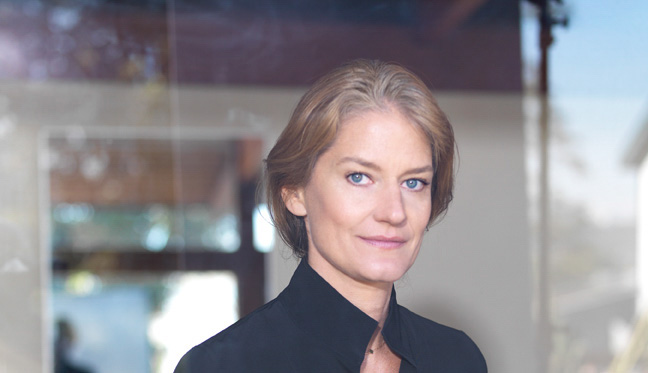Photographer, UCLA professor to feature immersive exhibition in Los Angeles

Mona Kuhn, an adjunct photography professor at UCLA, will feature her installation in Vancouver in April, and in Los Angeles in September. Her photography, featured in the installation, utilizes light and a desert landscape to symbolically portray human self-discovery in a natural environment. (Courtesy of Mona Kuhn)
By Rachel Hefner
March 6, 2019 9:51 p.m.
This post was updated March 11 at 11:43 a.m.
Photographer Mona Kuhn said her art has always existed on untouchable white walls. This September, she wants guests to take a physical step inside of it.
Her 5,000-square-foot exhibition, titled “Mona Kuhn: Experimental,” debuted in October at The Fruit gallery in North Carolina. Kuhn, an adjunct photography professor at UCLA, will attend an artist talk at The Polygon Gallery in Vancouver in April before bringing her installation to an unknown location in Los Angeles in September. Kuhn said her immersive installation surrounds guests with sounds, images and projections that allow them to interact with her artwork, rather than simply observing it passively. Her photography, featured in the installation, utilizes a desert landscape and light to symbolically portray human self-discovery in a natural environment, she said.
“I think what I would like (visitors) to get out of this (installation) is a sense of empowering themselves to get to know themselves,” Kuhn said.
“Mona Kuhn: Experimental” is an extension of Kuhn’s photographic series titled “She Disappeared into Complete Silence.” The series, shot just outside of Joshua Tree National Park, features a nude female subject encased by a modern glass structure. In her photos, Kuhn said she was able to capture reflections of the desert on the outer surface of the glass while simultaneously photographing the subject standing behind it. The glass structure surrounding her subject represents how individuals grapple with their own mental limitations within intimate, private spaces, she said.
Rodrigo Valenzuela, an assistant photography professor at UCLA, said Kuhn’s experimentation with reflections and light either reveals the interior of a subject or enshrouds them in shadow. By controlling the effects of light, Kuhn gives the appearance that her subjects are disappearing into the landscape, Valenzuela said.
“You are always looking at two things,” Valenzuela said. “(Kuhn) forces you to see something that is not what you thought was the protagonist of the image.”
[RELATED: Alumna uses photography to create conversation and capture stories of abortion]
After completing the series, Kuhn transformed her photography into a traveling gallery and then into an experimental publication. Finally, she developed the month-long multimedia installation at The Fruit gallery. The mixed media installation features two primary rooms in which visitors are encouraged to interact with the artwork. Upon entering, guests are confronted with a 12-foot image of a vast, desert sky printed on triangular vinyl. Kuhn said the wide base of the triangle grounds the image here on Earth while the uppermost peak points to the unknown.
After stepping through a slit in the vinyl, guests are surrounded by their own distorted reflections in walls of rumpled mylar, a reflective polyester film. While observers are often reluctant to touch pieces of art, Kuhn said she encourages them to squeeze their bodies through hanging strips of mylar in order to enter the second space. By moving past their own reflections, Kuhn said guests are able to metaphorically surpass the physical self and move into deeper contemplations of the mind.
“It was really important for me to have this little bit of pushing (visitors) into this out-of-body experience,” Kuhn said.
Kuhn said she intentionally deviates from traditional gallery designs, which often feature untouchable artwork hung on white walls. Instead, in the second room, she presents her photos as monochromatic vinyls backlit by video projections of the same colors. The images hang unframed in the middle of the room so visitors can move behind them while illuminated by the same monochromatic projections. Kuhn said the room design alludes to a uniformity that exists in the unconsciousness of every individual beneath their physical personas.
“We’re all pretty much the same when it comes to a certain unifying unconscious. There’s no shape – there’s no form.” Kuhn said. “It’s just a certain energy.”
[RELATED: New ways of seeing the sea: Installations invoke emotions of environmental change]
Accompanying the projected elements and the large-scale photography, Kuhn and composer Boris Salchow also designed sounds that would permeate the audience’s perception of their environment. Sounds of harsh winds surround visitors within the first room as they confront their own dismembered reflections, Salchow said. As guests move into the second space, they are then greeted by the sound of recorded string instruments.
In addition to the tranquility of the strings, Salchow’s augmented recordings of a fly attempting to escape a drinking glass infuse the room with a tone of suspense, Kuhn said. Salchow said wind often alludes to change, and Kuhn recognized an element of the human drive for survival in the fly’s struggle. The fragility of the fly’s wings beating against the glass reiterates the struggle of her photographed subject, Kuhn said. Both Salchow and Kuhn, however, felt that visitors should determine for themselves the meaning behind the sounds and images.
In addition to experimenting with photography and multimedia installations, Kuhn teaches UCLA students how to compile their own photographic collections into portfolios. Her focus with her UCLA students, much like her focus within her artwork, is to pull the deeper messages out from behind the photographs, she said.
“I’m not really interested in photography,” Kuhn said. “I’m interested in what it is that you have to express that happens to be with the medium of photography.”

